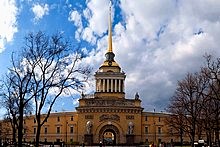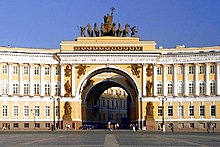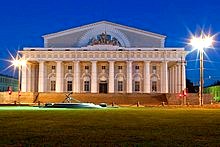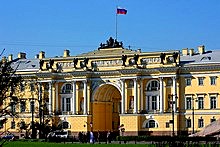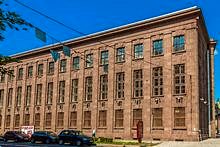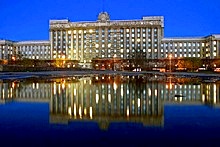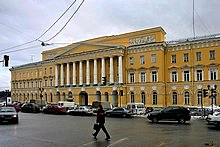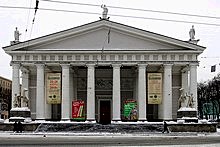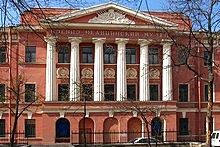Administrative and Government Buildings
In Russia, the use of architecture as a statement of power came to its peak in the reign of Josef Stalin, but that era's preference for severe classical forms and monumental statuary has antecedents in Russia going back well into the 18th century.
Although the city was relatively neglected during the Soviet period, as the capital of the vast Russian Empire, St. Petersburg required more than its share of governmental and administrative buildings, and many of them are masterpieces of neoclassicism and Empire style.
Once a shipyard and then the headquarters of the Russian Navy, the Admiralty is one of the oldest and the most impressive buildings in St. Petersburg, with its magnificent neoclassical decorations and renowned gilded spire.
Symbolic of the power of Russia's Imperial Government, this magnificent neoclassical building opposite the Winter Palace is most famous for the sculpture on its triumphal arch, erected to commemorate Russian victory over Napoleon.
Located on the spit of Vasilevskiy Island, this fine neoclassical building was designed to resemble a Greek Temple. It is part of one of St. Petersburg's most famous vistas, and has for many years housed the Central Naval Museum.
This magnificent neoclassical building next to the Bronze Horseman was built in the early 19th century to house two of Imperial Russia's most powerful institutions, the Senate and the Synod of the Russia Orthodox Church.
Built by the renowned German designer Peter Behrens in 1913, this monumental building was derided by the public and scorned by critics, but embodies the muscular neoclassicism that would dominate Soviet architecture under Stalin.
The largest and most impressive monument to Stalinist Empire architecture in St. Petersburg, the House of Soviets is only 60 years old, but has a rich and varied history as a military command post and the site of important scientific research.
Flanking the Field of Mars in one of St. Petersburg's most beautiful areas, this huge neoclassical building was designed by Vasily Stasov and was for several decades the headquarters of local electricity monopoly Lenergo.
Modeled on a Greek temple, this striking white building was once the riding school for an elite cavalry regiment, and is now used for art and trade exhibitions. Right next to St. Isaac's Cathedral, it is particularly famous for its equestrian statuary.
Located on one of St. Petersburg's most beautiful streets, this fine neoclassical building is the historic home of Russia's state postal service. Still the city's central post office, it is particularly notable for the covered bridge linking it to the building opposite.
A famous local hospital originally built for the elite Semyonovsky Guards Regiment, this imposing dark-pink building opposite Vitebsk Rail Station was reconstructed after the Second World War to house the Museum of Military Medicine.

